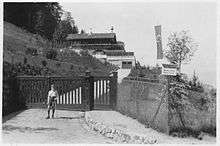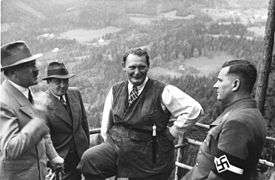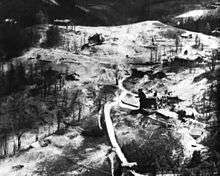Obersalzberg

Obersalzberg is a mountainside retreat situated above the market town of Berchtesgaden in Bavaria, Germany. Located about 120 kilometres (75 mi) southeast of Munich, close to the border with Austria, it is best known as the site of Adolf Hitler's former mountain residence, the Berghof (demolished) and of the mountaintop Kehlsteinhaus, popularly known in the English-speaking world as the "Eagle's Nest".[1] The Nazi past of the place is subject of the Dokumentationszentrum Obersalzberg museum opened in 1999.
History
The name of the settlement area derives from the rock salt deposits in the former Prince-Provostry of Berchtesgaden. Salt mining at Pherg is documented since the 12th century; the place was part of the provostry's eight localities (so-called Gnotschaften) mentioned in the first land register of 1456. From 1517 the Petersberg gallery was built, the first of the Berchtesgaden salt mine which became the economic base of the Prince-provostry. With Berchtesgaden it was securalised in 1803 and passed to the Kingdom of Bavaria in 1810.

Salzberg was re-established as a Bavarian municipality in 1817. Plans by Nazi authorities to merge it with Berchtesgaden were not carried out and Salzberg was not incorporated into Berchtesgaden until 1972.
Hitler's retreat

In 1877 Mauritia Mayer, a pioneer in terms of Alpine tourism, opened the Pension Moritz boarding house in Obersalzberg. In the late 19th century German intellectuals like Mayer's close friend Richard Voss, artists such as Clara Schumann, Johannes Brahms, Joseph Joachim, Peter Rosegger, Ludwig Ganghofer, Ludwig Knaus, and Franz von Lenbach as well as industrialists like Carl von Linde began using the area as both a summer and winter vacation retreat. The Obersalzberg boarding house was leased to the former racing driver Bruno Büchner in the early 1920s; when he acquired the property in 1928, he renamed it Platterhof inspired by Richard Voss' novel Zwei Menschen.
The scenic landscape and sweeping mountain views also attracted Adolf Hitler, who in 1923 visited his party fellow Dietrich Eckart at the Obersalzberg boarding house, shortly before the Beer Hall Putsch and his imprisonment at Landsberg. It was in a cabin on the premises where after his release from custody in 1925 he dictated Part Two of Mein Kampf, which earned him large royalties. He became so fond of the area that by 1928 he began using his royalty income to rent a small chalet nearby called Haus Wachenfeld from the widow of a Buxtehude manufacturer. Hitler put his half-sister Angela Raubal in charge of the household, together with her daughter Geli.

Several months after the Nazi seizure of power (Machtergreifung) in January 1933, Chancellor Hitler purchased Haus Wachenfeld and began making a series of three important renovations. The first included window shutters and a small office, followed a year later by a winter garden and stonework; finally the most extensive in 1935-1936 when the once modest chalet was finally transformed into the sprawling landhaus known as the Berghof.
Security zones
Around Hitler's home, several Nazi leaders such as Hermann Göring, Martin Bormann and Albert Speer acquired residences. By 1935-36 Party Secretary Bormann had all residents of Obersalzberg either bought out or evicted, and three security zones were installed that encompassed the entire area.[2] The expropriation not only concerned the secondary residences, but also several Alpine farms local families had held for centuries. After the demolition of the existing development, the so-called Führersperrgebiet shielded Hitler and his staff from public access. Two other security zones protected the heavily expanded SS and SD barracks, support staff, guest houses, underground bunkers and air raid shelters.
From 1938 Bormann also had the Kehlsteinhaus lodge erected on a rocky promontory, including a lift system from the upper end of the access road. Presented to Hitler on his 50th birthday in 1939, he nevertheless seldom visited it, though he and his mistress Eva Braun spent much time at Obersalzberg. From 1937 the German Reich Chancellery maintained a second seat in the nearby village of Bischofswiesen with Hitler receiving numerous guests of state at the Berghof. His last known visit was in 1944; he left for his Wolf's Lair headquarters on July 14 (see: 1944 Adolf Hitler assassination attempt) and never returned.

The premises - except for the Kehlsteinhaus - were heavily damaged by an Allied air raid on 25 April 1945. The remains were set on fire by retreating SS troops and plundered by locals.
US Army
US troops occupied the area on May 4. The former Nazi Party realties officially passed to the State of Bavaria in 1947, which instead of restoring them to their original owners sold them to the Steigenberger Hotels company. However, the Obersalzberg remained in use as a recreation park by the US military. Several structures, like the Platterhof, later General Walker Hotel, were rebuilt, while the ruins of Hitler's, Göring's and Bormann's residences were eradicated. The contract with Steigenberger was reversed in 1964.
The Americans did not withdraw until 1996, whereafter the Bavarian state government facilitated the erection of a hotel (operated by the InterContinental Hotels Group since 2005) and the Dokumentationszentrum Obersalzberg on the area's history, run by the Munich Institut für Zeitgeschichte.
It is also where the book The Boy at the Top of the Mountain by John Boyne was set.
Buildings during the time of National Socialism
- Berghof (Hitler's private home)
- Partei-Gästehauses „Hoher Göll“/Today Dokumentationszentrum Obersalzberg
- Gutshof
- SS Kaserne, Barracks
- Gärtnerei/nursery
- Kehlsteinhaus ("Eagle's Nest")
- Pension Moritz
- Platterhof/later General Walker Hotel
- Mooslahnerkopf Teehaus
- Hotel zum Türken/RSD, Sicherheitsdienst, Security Service
- Kamphäusl/Hitler dictates part two of Mein kampf
- Gutshof/Today SkyTop Lodge, Golf course restaurant/pro shop
- The houses of Martin Bormann, Hermann Göring and Albert Speer
See also
- Obersalzberg Speech
- National Redoubt (the supposed Nazi "Alpenfestung" [Alpine Fortress])
References
- ↑ Compare: Wilson, James (2014). Hitler's Alpine Headquarters. Pen and Sword. p. 205. ISBN 9781473831872. Retrieved 2016-03-28.
On 18 October 1938, the French Ambassador, André François-Poncet visited the Kehlsteinhaus, while later commenting on the experience he used the term 'Eagle's Nest' in his description of the event, in doing so he coined a new name for the building, a name that has been used ever since.
- ↑ http://www.thirdreichruins.com/obersalzberg.htm
External links
| Wikimedia Commons has media related to Obersalzberg. |
- Detailed pictorial history of the Obersalzberg in the Third Reich (self-published source)
- Pictures of the area taken in October, 2006
- Dokumentationszentrum Obersalzberg (German)
- Obersalzberg and Kehlsteinhaus Pictures (self-published source)
Coordinates: 47°37′52″N 13°3′21″E / 47.63111°N 13.05583°E